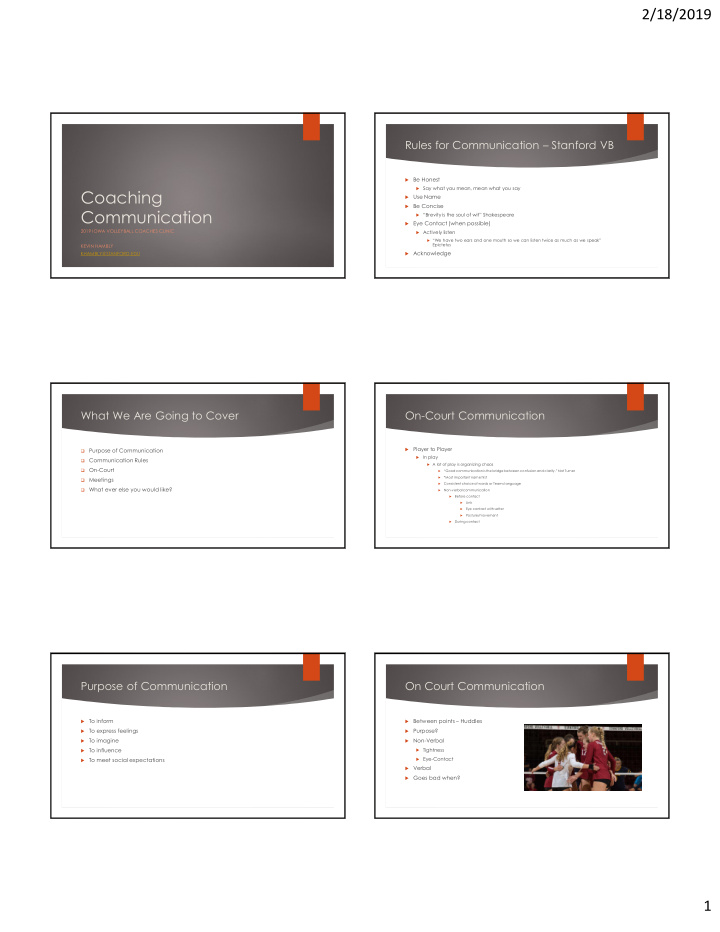



2/18/2019 Rules for Communication – Stanford VB Be Honest Say what you mean, mean what you say Coaching Use Name Be Concise Communication “Brevity is the soul of wit” Shakespeare Eye Contact (when possible) 2019 IOWA VOLLEYBALL COACHES CLINIC Actively listen “We have two ears and one mouth so we can listen twice as much as we speak” Epictetus KEVIN HAMBLY KHAMBLY@STANFORD.EDU Acknowledge What We Are Going to Cover On-Court Communication Player to Player Purpose of Communication In play Communication Rules A lot of play is organizing chaos On-Court “Good communication is the bridge between confusion and clarity.” Nat Turner *Most important name first Meetings Consistent choice of words or Teams language What ever else you would like? Non-verbal communication Before contact Link Eye contact with setter Posture/movement During contact Purpose of Communication On Court Communication To inform Between points – Huddles To express feelings Purpose? To imagine Non-Verbal To influence Tightness To meet social expectations Eye-Contact Verbal Goes bad when? 1
2/18/2019 Systems of Communication for Players Get to know each other meetings Assignments Rules Setter Meal Offense Face each other Libero Passing No phones Defense No TV’s Changes Has to last on hour Mo Middle Blocking What happens? Dorn OH’s absent Player to Player Coach to Player Struggle with Confrontation Importance of being one-self Carefrontation Eliminate Sarcasm attempt Bigger Conflicts Feedback Created Rules Name first Concise Space for questions No Rhetorical Questions Conflict Resolution Coach to Player Face each other Feedback Principles No raising of the voice Positive v. Negative Emotions good – yelling counter productive Instructive One person speaks other listens Let 30 seconds pass (feels like a long time) Find language that works Receiver repeats what they heard Efficiency is key If agreed message was the same move on to 6 Then offers opinion/rebuttal/insight/etc… Needs to hit home quick and strong 3 – 7 are repeated until both sides have expressed opinions and talked through issues Needs to work for athletes No longer than 20 mins. After 20 mins leave and come back to it the next day. External Focus This came from a psychologist – not always followed If someone gets too emotional both walk away come back to it 24 hours later Cueing After opinions are expressed and a resolution is determined both parties repeat resolution/solution Examples Check back in 24 hours later 2
2/18/2019 Coach to Player Team Meeting When I am frustrated Listen! I ask myself some questions Watch! Who am I frustrated with? Meet in a circle Players Me Watch reactions Remove identity from performance of players Players and Coaches Are their intentions good? Uncomfortable silence Is their effort where we want it? Coaches like to talk/want to fill time Communication I choose is based on these questions No effort = Crazy person Players wanting to share ideas as someone else is talking Others mean I need to change drill or how I am communicating skill/system Example Back to playing with the language Volleyball Bad Design Timeouts Individual Meetings What I used to do My meetings with players They pick the spot What I do now We have the same rules as players do in their meeting Break into groups Positional What I do Erin Listen Staff Ask questions Set Expectations Whole Group Together Define Roles Most important thing I do! Team Meetings Conclusion Everyone willing to speak Communication is more than just give speeches Safe Environment Need to treat it as you do any other system No judgment There is a lot of research on communication On Task Players want and need communication as much as anything else Honest! 5 Dysfunction discussion example Questions? 3
Recommend
More recommend